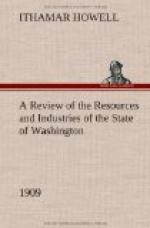[Page 32] Washington’s educational system.
The importance of a complete and well rounded public educational system has not been overlooked at any stage in the growth and development of this commonwealth. From kindergarten to university no link is wanting to supply the ambitious boy or girl with the very best training that modern educational experts have evolved.
The common school system of the state is based upon the theory that every child must be educated, and that the state must provide the facilities for the accomplishment of this purpose. This theory has been carried out so thoroughly and intelligently that there is scarcely a child in the state of school age who does not live within easy reach of a school house. Moreover, attendance is compulsory and no child is excused unless satisfactory reasons are presented to the proper authorities.
EDUCATIONAL ENDOWMENT.
Upon admission of Washington to statehood a land endowment was granted to the state by the federal government for common school purposes which in round numbers totals nearly two and one-half millions of acres. This land is offered for sale or lease by the state, through the office of the state land commissioner, and the proceeds constitute a permanent and irreducible fund to be invested for educational purposes.
In addition to the foregoing lands, the state university has an endowment of 100,000 acres; the agricultural college, 90,000 acres; the scientific school, 100,000 acres, and the state normal schools, 100,000 acres. As yet only a small portion of these lands has been disposed of. The expense of maintaining our schools, therefore, is met almost entirely by taxation.
[Illustration: Plate No. 25.—View of the Country Near Curlew, Ferry County.]
[Illustration: Plate No. 26.—Three-Year-Old Orchard, Near Pasco, Franklin County.]
[Illustration: Plate No. 27.—Combined Harvester Operating in the Wheat Fields of Franklin County. This Machine Cuts, Threshes and Sacks the Grain, Depositing the Filled Sacks on the Ground as it Moves Through the Field.]
[Illustration: Plate No. 28.—(1) A Jefferson County Country Home. (2) A logging Railroad, Jefferson County. (3) Prize Products, Jefferson County.]
[Illustration: Plate No. 29.—Jefferson county Rural views. Field of Oats and Vetch Yielding 5 Tons Per Acre. Herd of High-Grade Holstein Dairy County.]
[Illustration: Plate No. 30.—View of Waterfront, Port Townsend, Jefferson County.]




